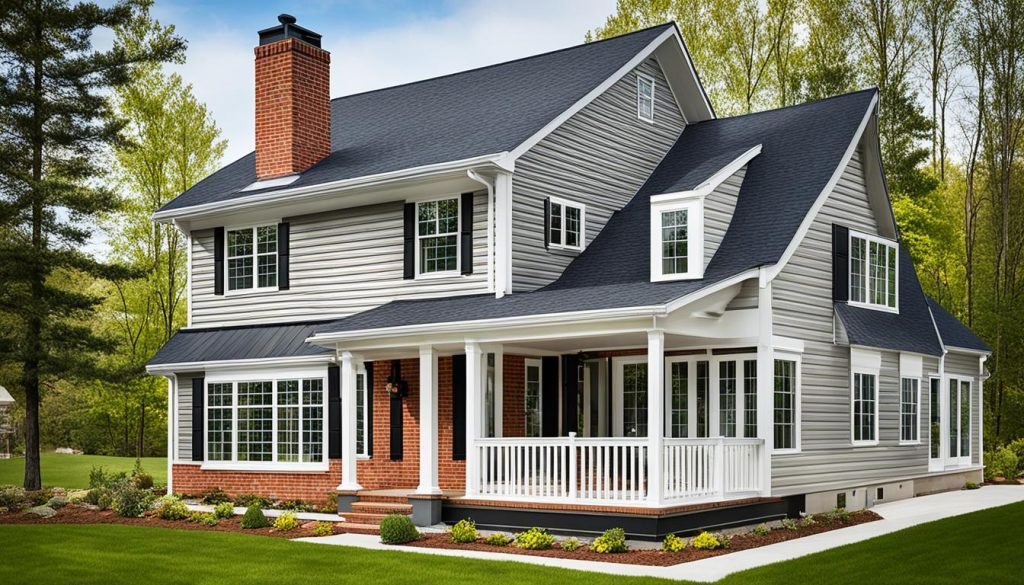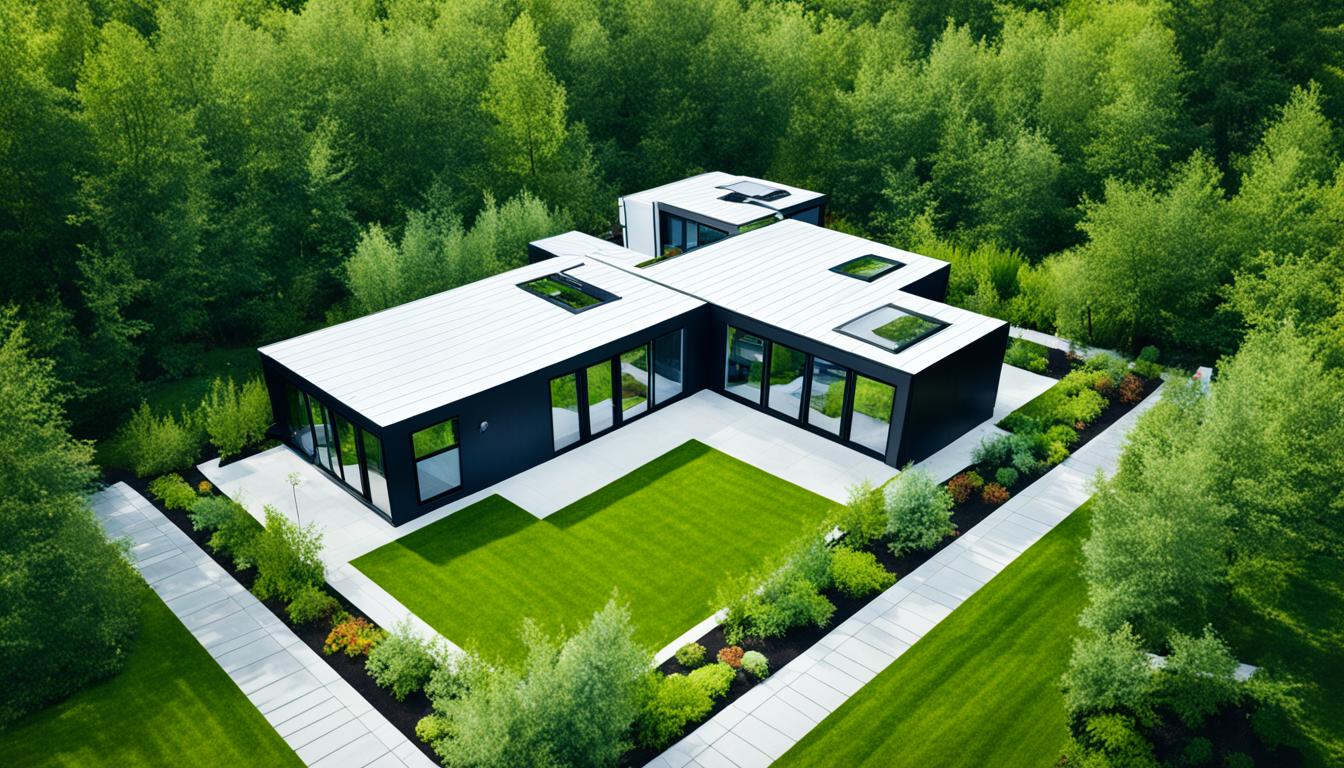Did you know that modular homes have become increasingly popular in recent years? In fact, the prefab housing market is projected to reach a value of $11.8 billion by 2027!
Modular homes, also known as prefabricated homes, are revolutionizing the way we think about home construction. They offer a modern, cost-effective, and sustainable alternative to traditional stick-built homes. If you’re curious about what modular homes are and how they can benefit you, keep reading!
Key Takeaways:
- Modular homes are prefabricated homes that are built in a factory and assembled on-site.
- They offer numerous benefits, including cost savings, energy efficiency, and customization options.
- Modular homes can be built more quickly than traditional homes and follow modern design trends.
- The cost of a modular home can vary but is generally less expensive than a traditional stick-built home.
- Considerations such as planning permission and building regulations are important when building a modular home.
The Construction Process of Modular Homes
When it comes to building modular homes, the construction process offers several advantages. Modular homes are constructed in a factory environment, where each module is carefully built and assembled. Let’s take a closer look at the modular home construction process.
- Flooring System: The construction process begins with the flooring system. This foundation ensures stability and durability for the entire structure.
- Wall and Roof Systems: Once the flooring system is in place, the construction of the wall and roof systems commence simultaneously. This approach allows for efficient construction and saves time.
- Module Transportation: After the modules are completed, they are transported to the building site. This transportation process is carefully planned to ensure the safe delivery of each module.
- Assembly and Connection: At the building site, the modules are assembled and connected to form the final structure. Skilled professionals ensure that each module fits together seamlessly, resulting in a well-built home.
One of the key advantages of modular home construction is the ability to carry out concurrent site work and building construction. This means that while the modules are being constructed in the factory, site preparation and foundation work can also be underway. As a result, the overall construction time is significantly reduced compared to traditional stick-built homes.
| Advantages of Modular Home Construction Process |
|---|
| Efficient and controlled construction environment |
| Simultaneous construction of modules and site work |
| Reduced overall construction time |
| Precisely assembled modules for a high-quality home |
Benefits of Modular Homes
Modular homes offer numerous benefits that make them a popular choice for homeowners. Whether you’re looking for a sustainable and energy-efficient option or you simply want a modern and customizable home, modular homes provide the perfect solution.
One of the key advantages of modular homes is their construction with high-quality materials. These homes undergo strict quality control in a factory setting, ensuring a higher level of quality compared to traditional stick-built homes.
Furthermore, modular homes are known for their energy efficiency. With tight specifications and insulation, these homes provide better insulation and reduce energy consumption, leading to lower utility bills and a smaller carbon footprint. They align with the growing interest in sustainable living and are considered a green choice.
Customization is another significant benefit of modular homes. Homebuyers have the freedom to personalize their homes to suit their preferences, from choosing interior finishes to adding specific features or layouts. This flexibility allows homeowners to create their dream home tailored to their unique needs.
When purchasing a modular home, buyers can also enjoy warranties and standard features such as stainless steel appliances and energy-efficient windows. These added elements enhance the overall quality and value of the home.
Additionally, modular homes offer quick construction time compared to traditional homes. As components are pre-built in a factory, the construction process is efficient and streamlined, resulting in shorter construction timelines. This means homeowners can move into their new homes sooner and start enjoying their modern and well-designed spaces.
Speaking of design, modular homes follow the latest trends in architecture and interior design. With a focus on clean lines, open floor plans, and contemporary aesthetics, these homes encompass the best of modern design. They offer stylish and functional living spaces that cater to the needs and tastes of today’s homeowners.

Benefits of Modular Homes:
- Constructed with high-quality materials
- Energy-efficient and sustainable
- Customizable to suit buyer’s preferences
- Warranties and standard features included
- Shorter construction time compared to traditional homes
- Follow modern design trends
Cost of Modular Homes
When considering building a home, one of the important factors to consider is the cost. Modular homes offer an attractive option for those looking for an affordable and efficient solution. The cost of a modular home can vary depending on several factors such as size, location, and amenities.
Compared to traditional stick-built homes, modular homes are generally less expensive. This is due to the efficient construction process and reduced overhead. Modular homes are built in a controlled factory environment, which allows for better cost management and minimized material waste.
The average cost of a base model modular home typically ranges from $120,000 to $150,000. However, it’s important to note that this price can increase when considering finishing costs and additional extras. Upgrades such as premium finishes, appliances, and customization options can add to the overall cost.
Fortunately, financing options are available through manufacturers, making modular homes more accessible for prospective homeowners. Additionally, modular homes can be a more affordable option for those looking to build in hard-to-reach or remote areas.
Benefits of Modular Home Costs
- Cost-effective alternative to traditional stick-built homes
- Efficient construction process and reduced overhead
- Lower average cost compared to traditional homes
- Financing options available through manufacturers
- Affordable option for remote or hard-to-reach areas
By choosing a modular home, not only can you enjoy the benefits of a cost-effective solution, but you also reap the rewards of a well-constructed and customizable home. Don’t let budget constraints deter you from exploring your options. With modular homes, affordability and quality go hand in hand.
Modular Homes vs Traditional Homes
When it comes to choosing between modular homes and traditional stick-built homes, buyers often weigh the advantages and disadvantages of each option. While modular homes offer several benefits such as cost savings, faster construction time, and customization options, they may not be the preferred choice for everyone.
Modular homes are known for their cost effectiveness. The efficient factory construction process reduces overhead costs, making them generally more affordable than traditional homes. Additionally, modular homes can be built in a shorter timeframe, saving both time and money for buyers.
Customization options are another factor to consider. While modular homes can be customized to a certain extent, they may have limitations compared to traditional homes. Traditional homes offer more flexibility in terms of architectural design and layout options, allowing buyers to fully personalize their living space.
When it comes to perception and market value, modular homes may vary in different areas. While they are becoming increasingly popular, some buyers may still view traditional homes as more desirable or hold certain stereotypes about modular homes. It is important to consider local real estate market opinions and preferences when making a decision.
Another consideration is the loan process. Financing options for modular homes can be more complicated compared to traditional homes. Lenders may have stricter requirements and guidelines for modular home loans. Buyers should be prepared for potential challenges and work closely with lenders who specialize in modular home financing.
Ultimately, the choice between modular homes and traditional homes depends on individual preferences, budget, and location. It’s important to carefully weigh the pros and cons of each option and make an informed decision based on personal needs and circumstances.

| Modular Homes | Traditional Homes | |
|---|---|---|
| Cost | Generally more affordable | Varies depending on location and features |
| Construction Time | Faster construction process | Longer construction time |
| Customization Options | Some limitations compared to traditional homes | More flexibility in design and layout |
| Perception and Market Value | Vary in different areas, may have some stereotypes | Often viewed as more desirable |
| Loan Process | Can be more complicated | More straightforward |
Planning and Building Considerations for Modular Homes
Before embarking on the construction of a modular home, it is crucial to carefully consider the necessary planning permission and building regulations. While modular homes do offer customization options, they must still meet local regulations and obtain the required permits and approvals. To ensure compliance with all requirements, it is highly recommended to consult professionals and engage with local authorities.
Consulting experts who specialize in modular home construction can help navigate the complex landscape of planning permission and building regulations. They can provide valuable guidance on the specific requirements for modular homes in the chosen location. By soliciting their expertise, homeowners can ensure a smooth and seamless process while adhering to all regulations.
Furthermore, when selecting the location for a modular home, several factors need to be taken into account. Besides considering the affordability of land, it is important to assess local authorities’ openness to innovative housing solutions like modular homes. Additionally, proximity to transportation routes and utility infrastructure should be considered to facilitate a quick and efficient delivery and installation process. By carefully evaluating these aspects, homeowners can maximize the benefits of modular home construction.

Leave a Reply
You must be logged in to post a comment.